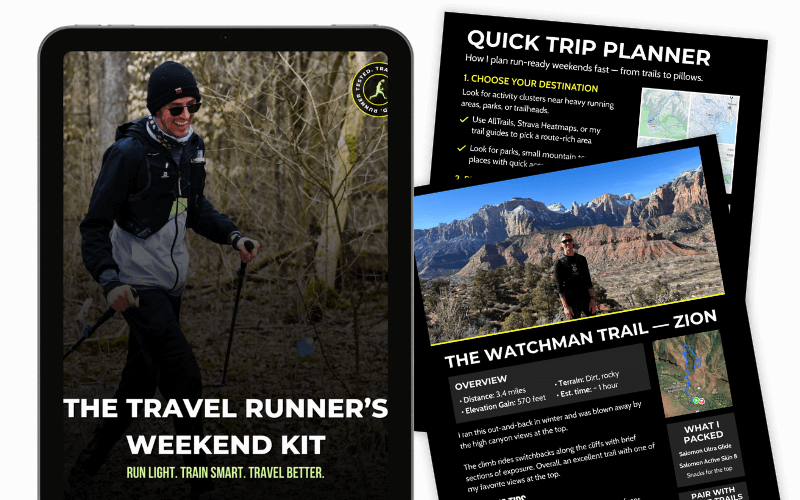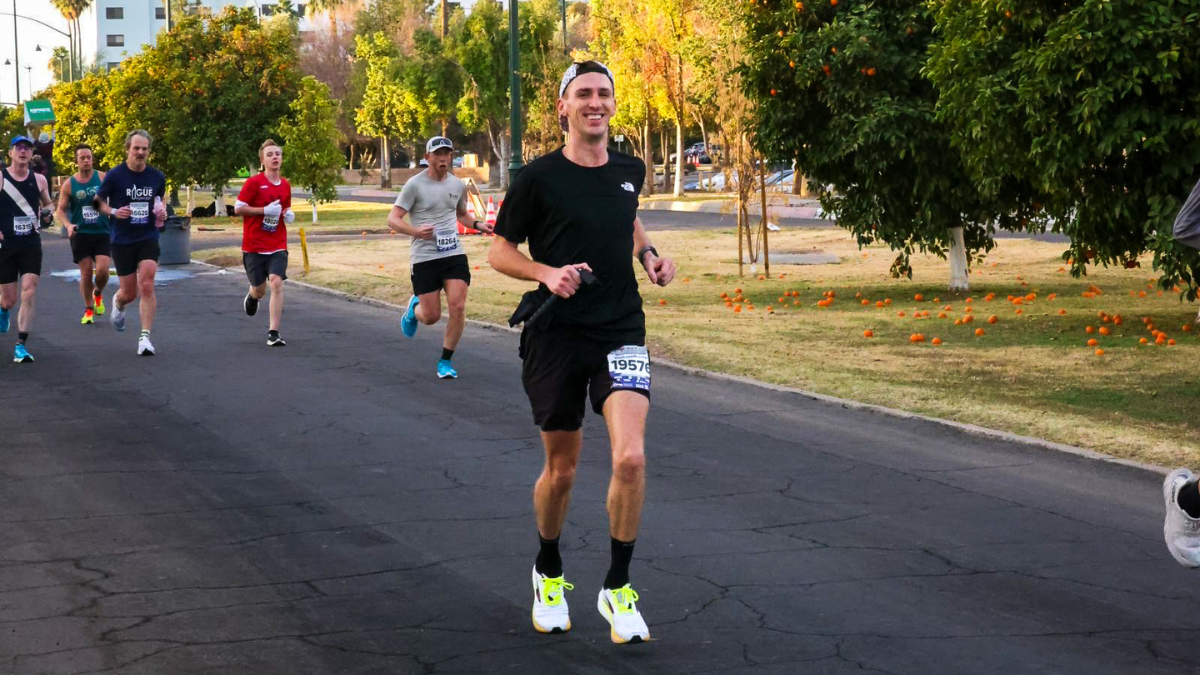Destinations
Sweeping alpine ridges. Endless mountain views. And a quad-burning climb that makes you question your life choices.
But then it rewards you tenfold.
That’s the Franconia Ridge Trail Loop, one of the most iconic trails in the White Mountains, if not the entire U.S. The standard loop covers around 8 miles with around 3,900 feet of gain. And it links three major summits — Little Haystack, Mount Lincoln, and Mount Lafayette — via a rugged, rocky, and fully exposed trail.
I first ran it in June of 2025. My fiancee, Kaitlyn, and I were set to leave New Hampshire, but we decided to stay an extra day to take it on and enjoy some White Mountain National Forest trail running a bit longer. (It’d be the best call of the trip.)
So, this guide is built for other runners. I want you to enjoy it the same way. I’ll walk you through how to get there, the route itself, as well as a few planning details to help you plan your own run on the ridge.
Table of Contents
Franconia Ridge Trail Map
How To Get to the Franconia Ridge Loop Trailhead
The Franconia Ridge Loop starts from near the Lafayette Place Parking Lot in Franconia Notch State Park, right off I-93 in New Hampshire.
This is the main lot for the Falling Waters and Old Bridle Path trails — and it’s busy.
So, arrive early. On weekends, this lot fills by 7–8 a.m. (sometimes earlier in peak summer and foliage season). If you roll in late, you may end up parking along the highway and walking extra distance just to start your run.
Closest towns for food, lodging, and last-minute supplies:
- Lincoln (south) – 10 minutes away, with restaurants, gas, and outdoor shops.
- Franconia (north) – smaller but closer, with coffee, general stores, and a few dining options.
Pro tip: If you’re staying overnight nearby, try to base yourself in Lincoln or Franconia for the shortest pre-run drive. And always check the forecast before you head out — weather changes fast in Franconia Notch.
Running the Franconia Ridge Loop
The loop is typically run counterclockwise — up Falling Waters Trail to the ridge, across Franconia Ridge Trail (part of the Appalachian Trail), then back down Old Bridle Path.
Falling Waters Trail (Ascent)
- Distance: ~3 miles to Little Haystack
- Elevation gain: ~3,000 feet
The start of the trail is innocent enough. A small parking lot, a few port-a-potties, the sign for the trail, and a chill sidewalk into trail transition to get you started.

Then the climb comes. And this climb doesn’t pull any punches.
From the start, it’s a steady grind with rocks, roots, and multiple stream crossings. You’ll pass a series of waterfalls — Stairs Falls, Swiftwater Falls, and Cloudland Falls — which make great excuses to catch your breath a bit if need be.

For our run, we largely hiked the climb, especially once we got about .5 miles in and it got significantly steeper/more technical.
Kaitlyn didn’t enjoy this section as much. The relentless climb tested her patience (and legs), but it made reaching the summit of Little Haystack that much more rewarding when she arrived. I personally love the way the trees just stop and you turn around and the entire valley and forest is stretching out before you.

Definitely one of the more epic above treeline views, in my opinion.
Little Haystack is usually busy, and it definitely was for us. The highlight of this was getting to meet a man and his son who were absolutely killing it up the trail when we started as well and I gained a follower that day as he seemed super excited to find an amateur runner who also makes amateur content ?.

So enjoy the rest and the view for a bit if you’d like; we didn’t spend much time here before we started toward Mount Lincoln.
Franconia Ridge Trail (Little Haystack -> Mount Lincoln -> Mount Lafayette)
- Distance: ~1.7 miles
The ridge itself is rocky and exposed, with drops on either side and mountains as far as you can see.
So that will either make you nervous or excited. For me, it was incredible to run on, especially because we could finally run on the trail. I don’t get many ridgeline runs, so when I do I definitely cherish them (like I did a few days earlier on the Presidential Traverse).
The climb to Mount Lincoln is short but steep.

I was told that it was a false summit. It turns out this was actually a false statement. So I was quite relieved reaching the summit of Lincoln and letting the burn in my legs cool off a bit.
This peak was a bit less busy than Little Haystack, so it was nice to have it somewhat to ourselves for a bit, especially as we were passing people who were ahead of us or passed us while we waited on Haystack.
From there, you roll into a steady push toward Mount Lafayette, the highest point on the loop.

The trail rolls up and down for the most part, which is another great opportunity to get your running time in while you can. Eventually, the final climb to Mount Lafayette comes and, boy, it feels like a boss battle in a video game. Just relentless and never-ending.
Then, you pop out at the top for what I, and many others, consider the best view on the ridge. So definitely take the time to rest, enjoy it, and maybe enjoy a snack or two.

We would have, but the biting flies demanded we carry on without rest. So it was on to the Old Bridle Path.
Old Bridle Path (Descent)
- Distance: ~3.5 miles
The entire descent was way more technical than I had anticipated, especially at first.
The trail is just dotted with giant boulders. And where they aren’t, miniature versions slid in between to strike fear into your ankles. So I’d recommend taking your time on this section, that’s what we did at least.

This was the most troublesome part for me of the entire run.
I had sprained my ankle pretty severely the few days before on the Presi Traverse and likely didn’t allow it enough time to heal. And I really felt it on the descent as we jumped from boulder to trail to boulder to mud pit and everything in between.
I’d roll my opposite ankle a couple times on the way down in this section until we finally reached a mellower, more runnable trail…. where I’d roll it one more time for good measure.

So, moral of the story here, this is arguably the most dangerous part of the trail because of the technicality and also the sheer amount of obstacles in your way.
But you’ll still get some decent views along the way, so enjoy it (if you can).
Franconia Ridge Loop Details
- Distance: ~8 miles
- Elevation gain: 3,800+ feet
- Trail type: Loop
- Estimated time: 4-6 hours
What To Bring on the Franconia Ridge Loop
The Franconia Ridge isn’t your average weekend trot.
You’ll be climbing nearly 4,000 feet, spending a good chunk of time above ridgeline, and dealing with exposed, rocky footing for miles.
That means your gear can make or break your day.
So here’s what I took (so hopefully it helps you):
- Base layer
- Top layer (depending on season)
- Rain jacket (if necesssary)
- Running shorts
- Brooks Cascadia shoes (great with grip)
- Salomon pack/Outdoor Vitals pack
- Injinji socks
- Two 500mL water bottles
- Snacks
- Bug spray
Also, always remember to follow Leave No Trace and pack out what you pack in. Let’s keep the trails clean.
Best Time to Run Franconia Ridge
You can technically run the Franconia Ridge Loop Trail year-round.
But each season comes with a trade-off, and some are far better than others.
If I had to pick one season, it’d be fall (Late September-Mid October). The foliage is world-class, and running the ridge with a backdrop of reds, golds, and oranges would be something else.
| Season | Best For | Pros | Cons | Kyle’s Take |
|---|---|---|---|---|
| Fall (Late Sep–Mid Oct) | Foliage runs, crisp temps | World-class colors, clear air | Heavy crowds, parking fills before sunrise | My #1 pick — worth the early wake-up for the views |
| Summer (Jun–Aug) | Long alpine days, big ridges | Snow-free trails, reliable weather windows | Heat, humidity, relentless bugs | Great for long ridge days — bring bug spray |
| Spring (Late Apr–Early Jun) | Quieter trails, cool air | Less crowded, scenic snowmelt waterfalls | Mud, lingering snow, unpredictable weather | Good crowd/weather balance — but expect slow sections |
| Winter (Nov–Apr) | Solitude, snow-covered ridge | Unique, peaceful runs | Cold, ice, high skill required | Magical if you’re winter-ready; skip if you’re not |
Next would be summer (June-August) and spring (May-Early June).
Summer gives you long days, but super hot temperatures. This is when I ran it and it wasn’t too bad in terms of temperature, especially if you’re flexible with time/weather. And spring isn’t bad, but it can still be muddy and have snow/ice on the ridge, so traction gear may be necessary.
I’d only recommend winter (November-April) for experienced hikers/runners with the right gear (crampons, snowshoes, etc.). The ridge is fully exposed, and the conditions can get bad quickly.
Other Great Trail Options Nearby
I love running in New Hampshire, and I still have so many trails to run and write about. But, here are a few I have covered so far to help you plan your trail runs in White Mountain National Forest a bit better:
- Presidential Traverse (19 miles)
- Mount Willard (3 miles)
- Mount Moosilauke (7.5 miles)
Final Thoughts on the Franconia Ridge Loop Trail
The Franconia Ridge Trail is one of those runs that sticks with you (both mentally and in leg fatigue).
The climbs, the rocky ridgeline, the sweeping views — it’s the White Mountains at their best. And I truly see why many call it the best trail in White Mountain National Forest.
I won’t lie. I wasn’t too keen on staying an extra day as we were on the tail end of a long road trip. And I was being a bit crabby. But, standing on Mount Lafayette and looking back at the ridgeline, I’m glad Kaitlyn told me to stop being a baby. Because that run was very worth it.
So, if you’re making the trip, pack smart, pace yourself, and take it all in.
And, if you want to be fully ready for a weekend of epic runs like this, grab my Travel Runner’s Weekend Kit. It shows you how I plan all of these trips so you can fit them into your schedule, too.

Get the Runner’s Weekend Kit!
- 3 ready-to-run itineraries for national parks and weekend escapes
- My personal runcation packing list — what to bring (and what to skip)
- A quick-start trip planner to choose trails, book stays, and pack fast

Kyle Cash | Trail Journal
I’m Kyle — the runner behind The Travel Runner. I run trails all over the world to bring you stories, tips, and gear that actually works. From national parks to forgotten paths, I’ve got mud on my shoes and too many snacks in my pack.
Let’s go find new ground.



![8 Best National Parks for Trail Running [Runner-Tested]](https://www.thetravelrunner.com/wp-content/uploads/2024/01/wheeler-peak-mailerlite-300x169.png)

Leave a Reply